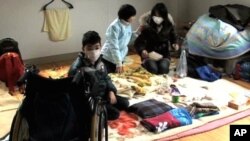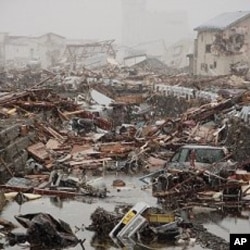Amid the desperate attempts by rescue teams to find anyone alive in the wreckage left by the Japan tsunami, survivors of the disaster are struggling to get by. Close to half a million people are estimated to be living in shelters, most sleeping on the cold floors of school gymnasiums. The very old and the very young are the most at risk.
Two-month-old Hina Tanaka is cradled in the arms of her aunt. She is the youngest homeless resident of the Rikuzentakata Gymnasium shelter. Her great grandmother Michiko Tanaka sits beside them - her home also destroyed by the tsunami.
When asked about the baby’s mother, she leaves the question unanswered.
Michiko says, "We came here last Friday, after the tsunami. We have been here since then."
The family are being given milk and diapers, but with no running water they are unable to bathe Hina.
Next to Hina and her family sits 11-year-old Mugen Takahashi, with his sister and mother. Despite being in a wheelchair, Mugen managed to escape the tsunami.
Mugen says his sister was at school when the tsunami struck and her teacher told the students to leave immediately. He says they went up the to the primary school, which is on higher ground, and the students managed to escape the tsunami.
Mugen’s grandparents did not manage to escape. They are among the hundreds killed when the tsunami roared through the town, consuming all in its path.
Outside, a group of men gather beside a fire to smoke and talk about the disaster that has befallen their town. Thick snow is falling and it is getting cold in the shelters. Local media say 14 elderly people at one shelter near here have died. There are fears that diseases like influenza are starting to spread.
Cycling through the wreckage of nearby Ofunato, Ai Omi stops to check her cellphone for messages.
She says she has friends all over the place - both around here, further south in Sendai and in Tokyo. She says she has been trying to call them to see if they are safe, if their families are safe, but cellphones are not working… The nuclear threat is scary [from the damaged power plant in Fukushima], but for people who live here next to the coast, she says, they are just worried about the future, how they can ever get their lives back.
|
Interview with Sayaka Matsumoto, spokesperson for Japanese Red Cross |
A little later we met Satoko Kino searching through the remnants of her family home. Kino and her father Ryomi manage to recover a treasured Buddha statue, a wooden plaque that was kept with the ashes of her late uncle - together with a bag containing her uncle’s letters.
"This stamp is my uncle’s name - his name is right here," Satako said.
They decide to take the recovered heirlooms to the family shrine in the hills above the town. The treasures are handed over to the priest who says he will give them a prominent place.
Tears well up in Satoko’s eyes. For her and her father, it is an emotional relief, they believe their ancestors will now rest in peace.
Many of Ofunato’s residents are coming to this shrine to pray, and to make plans for burying the loved ones they have lost. In the devastated town below, the survivors are struggling to see how they can make any plans at all for the future.















